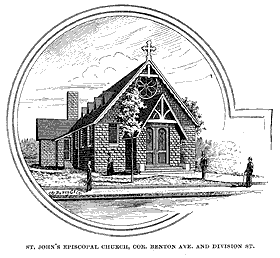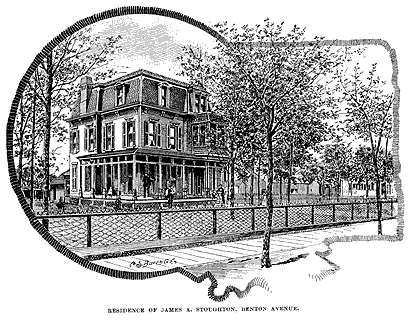SPRINGFIELD, MISSOURI AND SURROUNDINGS • 1889
(previous page) statement and is not likely to for years to come. Within less than nine years the city has advanced from 7,500 to THIRTY-FIVE THOUSAND PEOPLE. Within that period, too, a large and prosperous jobbing trade and a score of manufacturing industries have been developed,—street railways, electric light, gas and water works have been established; the Gulf Railway and its accompanying shops and offices, the new opera house, hundreds of new business houses, 3,000 homes, and a score of school-houses and churches have been built, carrying the city from the modest estate of a provincial country town up to the dignity of a cosmopolitan city, the acknowledged metropolis for one of the grand divisions of a great State. It has made this remarkable advancement without the aid of speculative booms. Its growth has been natural, steady, strong and healthful, and is the outcome of forces that inhere to the situation, and are in nowise extraneous or transient. First among these influencing causes is a FORTUNATE LOCATION, in the heart of a new and fast growing country, large and rich enough to foster a city of 200,000 souls—a country whose extent and splendid resources have already been briefly sketched in these pages. From Springfield, northeast to St. Louis, is 240 miles, Kansas City lies 200 miles northwest, Memphis 285 miles southeast, Little Rock 235 miles south, and Port Smith 178 miles southwest. Full half the country within this great radius, naturally, and of right, belongs to Springfield. Better still, than title deeds, she holds this splendid domain by right of possession, and has within it no rival to dispute her claim. Within this region are forests, coal fields, lead, iron, zinc, antimony, copper, manganese, fire clays and agricultural and horticultural interests great enough to build one of the mighty inland cities of the continent, and, if such a metropolis be not built here within the next twenty years, it will be the fault of the people of Springfield themselves. From a purely local standpoint, the city is more “BEAUTIFUL FOR SITUATION” than any other town of magnitude in the Southwest. It stands upon a series of charming wooded elevations, abounds in fine building sites, finely shaded streets and avenues, and from end to end is a beautiful tree-embowered city, whose elegant homes and deeply shaded lawns have an air of amplitude and leisurely comfort in refreshing contrast with the pinched and over-crowded towns of the East. It has ADMIRABLE NATURAL DRAINAGE, and from its commanding elevation on the crown of the Ozark divide, 1,400 feet above the sea, enjoys a clear, crisp, invigorating atmosphere and a measure of health quite unknown to the average city of its class. The city itself, with a good scope of outlying country, is a BEAUTIFUL NATURAL PARK, to whose native graces of billowy woodland, charming slopes, intervales, ravines and clear rock springs and brooks, the town builders have added numberless embellishments of art, until the whole situation is aglow with scenic attractions. THE NATIONAL BOULEVARD, nearly 100 feet wide and finely paved, leads out of the city three miles southward to the National and Confederate Cemeteries, where sleep hundreds of fallen heroes of neighboring battle fields, in burial grounds of surpassing beauty. The boulevard is one of the finest drives in the country. On the north side are delightful wood-fringed drives to “Doling’s Park,” just on the border of the city, and half a dozen miles further out is the PERCY CAVE, which reaches away into the cavernous depths of (next page)
Page
1 | 2 | 3 | 4 | 5 | 6 | 7 | 8 | 9 | 11 | 12 | 13 | 14 | 15 | 16 | 17 |
18 | 19 | 20 | 21 | 22 | 23 | 24 | 25 | 26 | 27 | 28 | 29 | 30 | 31 | 32 | 33 | 34 | 35
Springfield 1889 Home | Keyword Search | Engravings Thumbnails | Local History Home


